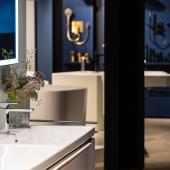The urban dimension of colour
Azzurra Bimbi - Esmalglass-Itaca Group
The rapid pace of urban growth all too often ignores an important need, that of decoration and beauty. We fail to realise just how crucial these factors are for our quality of life. We all know how redevelopment projects aim to make the suburbs more efficient, eco-sustainability and people-friendly, but it is perhaps not equally evident that they also need to be more visually attractive. Humans have always felt the need to improve the aesthetic quality of the places in which they live, and the quest for beauty has always been as important as the need for food, shelter and progress. Colour is often present as a tool for redeveloping places, although its potential is probably underestimated as our culture has not yet afforded it the important role it deserves.
“The starting point is the study of colour and its effects on men,” wrote Wassily Kandinsky in 1912 in “Concerning the Spiritual in Art”.
This must have been in the thoughts of Edvin Rama, the renowned Albanian artist who became mayor of Tirana in 2000 and prime minister of Albania in 2013, when just after being elected mayor of the country’s capital he embarked on a major redevelopment project in the city. As well as demolishing illegal buildings and restoring social spaces and important green areas, the mayor/artist used colour as the main instrument of social change in order to transform the chronic sense of resignation and indifference amongst Tirana’s inhabitants into hope and a feeling of identity and pride for their city. The city’s historic architecture, with its wealth of mouldings and decorations, was returned to its original (or assumed to be its original) colour, while modern buildings became authentic canvases for the work of contemporary artists. The façades of houses and large buildings took on striking, bright colours, often with unexpected and unusual colour contrasts that highlighted the discontinuity with respect to the cheerless grey of the past. Repainting entire neighbourhoods in a kaleidoscope of colours had the immediate effect of reawakening consciences and establishing a new code of social communication. Colour, used by Rama both as artistic expression and as a form of political action, had transformed art into a force for social cohesion. “I love the joy that colour can bring to our lives and to our communities. I have tried to carry something from my art over into my politics,” said Edvin Rama in a speech after completing his term in office as mayor in 2011.
Another example of urban transformation through the use of colour is the Favela Painting project by the two Dutch artists Jeroen Koolhaas and Dre Urhahan (known as Haas&Hahn). After arriving in Rio de Janeiro in 2004, Koolhaas and Urhahan proposed a project to redevelop the Vila Cruzeiro favela, notorious for its high levels of crime. Exploiting their talent and creative use of colour, they transformed the slum into what has been universally acknowledged as an open-air art gallery, helping to foster a new sense of belonging amongst its inhabitants. The project was so successful that the work of the Favela Painting Foundation, set up to redevelop run-down areas, has since continued uninterruptedly. After Vila Cruzeiro, the two artists moved on to the favela of Santa Marta, where they engaged the local community in repainting the main square, Praça Cantão, in a rainbow of colours. The social change that this engendered in terms of collective pride spurred the inhabitants to continue their project and gradually transform the aesthetics of the entire favela. Colour played a similarly important role in the subsequent projects by Haas&Hahn, such as Germantown Avenue in north Philadelphia, which was brought back to life in 2012 in a brightly-coloured wall painting extending across 54 buildings. Another example is the Vila Rosa neighbourhood of Port-au-Prince, Haiti, where the houses rebuilt after the 2010 earthquake were all repainted according to a colour scheme inspired by the bright local colours and chosen in consultation with the individual owners, thereby creating a unifying, linking effect between the buildings.
In cities, colour can be used to create a connection with tradition or bring renewal and change; it is evocation and surprise, integration or mimicry; it is a bearer of beauty and a fundamental ingredient of social behaviour. Shifting our attention from artistic projects to architectural redevelopment, we find that colour continues to play a key role in countless projects.
A multicolour vision certainly underpins the revamping project of the Santa Caterina market in Barcelona in 2005 by Studio Miralles Tagliabue EMBT, with its soft, dynamic roof made of brightly coloured ceramic scales, like a curtain billowing in the wind. The architects could hardly fail to take account of the vital, multisensorial space in which they were called on to work or of the architectural context of the square. This old, sleepy heart of the La Ribera neighbourhood was brought back to life, triggering a process of renovation of the surrounding rundown buildings.
In one of the most emblematic projects of this kind, Renzo Piano Building Workshop Architects used colour as a tool for injecting new life into the Central Saint Giles area in London in 2010. The original building was a large, opaque monolithic volume located in a strategic position within London’s urban fabric. The urban regeneration project proposed a large volume broken up by a series of plastic cuts. The multifunctional complex is thus perceived as a composition of individual parts, each of which is identified by a different façade colour. Colour creates diversification, as well as order and completeness, and becomes the leitmotif of the entire architectural composition. Renzo Piano loves to use word “surprise”, which he sees as an antidote to the monotony of urban spaces. He teaches us that buildings must not take possession of the site in which they are located, but “give the road back what it deserves”. In this respect, colour is the response of an architecture that dialogues with and is open to the collective social space: colour is the building’s response to “the miraculous organism that is the city, where everything must be based on participation, a sense of belonging and urbanity”.
Did you find this article useful?
Join the CWW community to receive the most important news from the global ceramic industry every two weeks





















